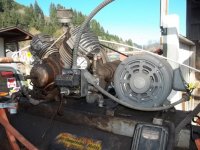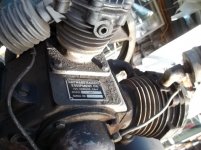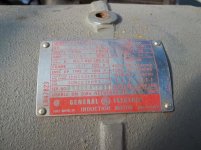Check the fan vanes in the compressor pulley for a directional arrow. I say this because the compressor likely uses splash lubrication in its crankcase. "Shippers" or "slingers" on the connecting rod bearing caps are often used to throw lube oil up where it needs to go. These shippers or slingers have a flat surface on the "leading" side to splash up the oil, and often taper down to the trailing edge.
The compressor may well have had an older motor with a non-standard frame, or simply had a motor with a larger frame than what it now has. The fact there are spacer/adapter bars between the motor's mounting feet and the mounting channel on the compressor's air receiver (tank) makes this apparent.
Without knowing bore & stroke of the compressor, it's hard to say what the minimum HP motor would be to drive it. For the size of compressor it appears to be, and the larger motor pulley, speaking from experience, the 3 HP motor would be pushing the envelope for minimum size. If you want to stick with 3 HP and go to a phase converter (solid state type loses some motor power), I'd go to a smaller motor pulley. This lowers the cubic feet per minute of air the compressor will deliver, but lets you get away with the 3 HP motor run off a solid-state phase converter. Of you try to find a single phase motor large enough to drive that compressor and running at 1725-1750 rpm, you will be in for some sticker shock at the prices.
A 3 phase motor is easily reversed, so one has to wonder about why the compressor was mounted as it is in relation to the motor. As I wrote, I would look for a directional arrow on the fan vanes in the compressor pulley ( used as the spokes of the wheel).
Another point which we've covered on this 'board many times over: an unknown/used air receiver or air tank is a potential bomb. Condensation (water) from the cooling of the compressed air in the receiver will have corroded the bottom area of the receiver. You do not know how thin the steel in that area now is. Air tanks can and do let go with little or no warning. When they do, the sudden release of compressed air is a violent expansion which can "unzip" the steel of an air tank once a failure starts. Pieces fly like shrapnel in many cases and the air tank with its compressor can get launched. Under ASME (American Society of Mechanical Engineers) pressure vessel design codes, a factor of safety of at least 5 is used in the design of new air receivers (tanks). Over time, with loss of steel to corrosion from within, the tank may seem sound, but the developed tensile stress in the steel of the tank shell reduces the factor of safety. A hydrostatic test (pressure test done with water pressure rather than compressed air) will come out OK in this case, but there may well be thinned areas of the tank shell. An ultrasonic thickness gauging will tell the tale of the actual thickness of the walls of the tank and its end heads.
The problem is taking a compressor and its tank apart for a hydro test and UT (ultrasonic thickness gauging) is something 99.9% of those of us who own and use compressors don't do. Air tanks are taken for granted in those 99.9% of the cases. Every so often, an air tank fails catastrophically in service and the results are never pretty. There is an old saying that the boiler and pressure vessel codes are "written in blood". I retired from a working powerplant where we had some huge compressed air storage tanks, and many smaller ones. Each year the insurance underwriters would send a "risk assessment team" of engineers to our plant. Each year
the engineers on the risk assessment team would ask for hydro test and UT records on air receiver tanks. We did not play around, and if an air receiver tank was getting a little thin, we cut it up so even as scrap, it could not be re-used by anyone else. Each year, also, the engineers on the risk assessment team had some new story of an air receiver than let go suddenly and did a lot of damage to the surrounding shop or plant it was located in. Fortunately, these failures seemed to occur at times and locations where no one was nearby to be injured or worse. A neighbor of a buddy of mine bought a "bargain" of an air compressor at a yard sale. It was one of those new direct-coupled compressors on a smaller air receiver, probably made in China for a big box store. This fellow started the compressor and discovered air was hissing out a pinhole rusted thru the bottom of the air receiver. Thinking nothing of it, he let the compressor charge up the tank, since it seemed to be capable of producing more compressed air than was leaking out of the tank. I do not know whether the guy used the compressor for anything, but my buddy- whose shop abuts this neighbor's property- heard a hell of a bang followed by a crash. My buddy ran out of his shop to see what happened at his neighbor's house. The neighbor said the compressed air receiver on his "bargain" had blown apart. It blew with enough force to launch the whole compressor and what was left of the tank skyward, getting to about the height of the eaves of the neighbor's house ( about 10 ft above the ground), before crashing back down to earth. The tank was "grenaded". The neighbor was shook up, but no other harm done.
Do yourself and your loved ones and anyone else who is likely to come near that compressor a favor and do not take a chance on the unknown air receiver tank. You have bought a used compressor, it has been cobbed together from your photos. There should be an ASME code data plate on the air tank. Clean it off and read it. It will give the thicknesses of the tank shell and end heads, as well as pressure rating at time of manufacture, and year of manufacture. You may be surprised by the age of the compressor and its receiver. Do not take it for granted, it is a potential bomb until you prove otherwise. Similarly, a new ASME code safety valve is dirt cheap insurance. However, until you establish the condition of the tank in terms of remaining thicknesses of metal vs original, it is false insurance to put on a new safety valve rated for the original set pressure. Old compressors and their tanks are potentially lethal unknowns. Because it is "only" compressed air, people tend to dismiss any ideas that there might be a potential danger in an old/unknown air receiver or old/unknown safety valve. A little insurance in the form of checking and properly inspecting the air receiver is time and money well spent considering it could save lives.











